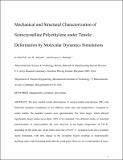| dc.contributor.author | Yeh, In-Chul | |
| dc.contributor.author | Andzelm, Jan W. | |
| dc.contributor.author | Rutledge, Gregory C | |
| dc.date.accessioned | 2017-04-13T17:21:55Z | |
| dc.date.available | 2017-04-13T17:21:55Z | |
| dc.date.issued | 2017-04-13 | |
| dc.identifier.issn | 0024-9297 | |
| dc.identifier.issn | 1520-5835 | |
| dc.identifier.uri | http://hdl.handle.net/1721.1/108115 | |
| dc.description.abstract | We have studied tensile deformations of semicrystalline polyethylene (PE) with molecular dynamics simulations at two different strain rates and temperatures. Compared to earlier studies, the modeled systems were approximately 5 times larger, which allowed significantly larger strains up to about 120% to be examined. Two different modes of structural transformation of semicrystalline PE were observed at the higher temperature of 350 K, depending on the strain rate. At the faster strain rate of 5 × 10⁷ s⁻¹, cavitation in the noncrystalline region dominated, with little change in the crystalline region, resulting in monotonically declining stress with increasing strain after the yield point. However, in a small number of cases, significant deviations from the average stress–strain profile were observed that correlated with topological constraints, such as bridges and bridging entanglements connecting crystalline regions separated by the noncrystalline region, and destabilization of the crystalline region. At the slower strain rate of 5 × 10⁶ s⁻¹, we observed repeated melting/recrystallization events and significant oscillations in stress associated with variations of density in crystalline and noncrystalline regions and the displacement of polymer chains from crystalline to noncrystalline regions. When averaged over an ensemble of starting configurations for semicrystalline PE, the oscillations were found to be less coherent from microstate to microstate and offset one another. The postyield stress became notably smoother and began to resemble the plastic flow observed macroscopically, followed by stress hardening at the later stage of deformation. At the lower temperature of 250 K, cavity formation was the only mechanism observed, for both strain rates. The interplay between the thermodynamic stability of the crystalline region and the topological constraints imposed by bridges and entanglements in the noncrystalline region is crucial to understanding structural transformations of semicrystalline PE during tensile deformations. | en_US |
| dc.description.sponsorship | U.S. Army Research Laboratory | en_US |
| dc.language.iso | en_US | |
| dc.relation.isversionof | http://dx.doi.org/10.1021/acs.macromol.5b00697 | en_US |
| dc.rights | Article is made available in accordance with the publisher's policy and may be subject to US copyright law. Please refer to the publisher's site for terms of use. | en_US |
| dc.source | Prof. Rutledge via Erja Kajosalo | en_US |
| dc.title | Mechanical and Structural Characterization of Semicrystalline Polyethylene under Tensile Deformation by Molecular Dynamics Simulations | en_US |
| dc.type | Article | en_US |
| dc.identifier.citation | Yeh, In-Chul; Andzelm, Jan W. and Rutledge, Gregory C. “Mechanical and Structural Characterization of Semicrystalline Polyethylene Under Tensile Deformation by Molecular Dynamics Simulations.” Macromolecules 48, no. 12 (June 23, 2015): 4228–4239. © 2015 American Chemical Society (ACS) | en_US |
| dc.contributor.department | Massachusetts Institute of Technology. Department of Chemical Engineering | en_US |
| dc.contributor.approver | Rutledge, Gregory C. | en_US |
| dc.contributor.mitauthor | Rutledge, Gregory C | |
| dc.relation.journal | Macromolecules | en_US |
| dc.eprint.version | Author's final manuscript | en_US |
| dc.type.uri | http://purl.org/eprint/type/JournalArticle | en_US |
| eprint.status | http://purl.org/eprint/status/PeerReviewed | en_US |
| dspace.orderedauthors | Yeh, In-Chul; Andzelm, Jan W.; Rutledge, Gregory C. | en_US |
| dspace.embargo.terms | N | en_US |
| dc.identifier.orcid | https://orcid.org/0000-0001-8137-1732 | |
| mit.license | PUBLISHER_POLICY | en_US |
